|
| |
Jan Jacob Kotte and His Dollar Princess
Philips DP70 double projector
|
This article first appeared in
..in 70mm
The 70mm Newsletter |
|
Written by:
Anton
Kotte, Eindhoven, The Netherlands |
Issue 55 - December 1998 |
|
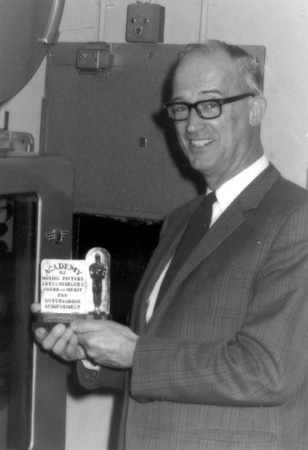 Jan
Jacob Kotte and his OSCAR next to his "Dollar Princess" Jan
Jacob Kotte and his OSCAR next to his "Dollar Princess"
In
this article Mr. Anton Kotte shares some remarkable moments and a
fascinating insight into his father's work for the Cinema Department of
the Philips Company in Eindhoven.
Philips
is known all over the world for electrical shavers, food processors,
consumer electronics and a "millon" other things. Little known
today perhaps is that Philips was a leading company in manufacturing a
series of outstanding motion picture projectors. The chief designer was
Mr. Jan Jacob Kotte. His masterpiece was the OSCAR award winning DP70 /
Norelco AA11 / Universal 35/70 projector from 1955.
As
announced in The 70mm Newsletter of June this year (issue 53) I will
tell you a few details about my father Jan Jacob Kotte
(29.09.1908-
19.05.1988), his passion for technology, his relationship with
his Cinema team at Philips ELA Department (Electro Acoustive Division)
and why he was so respected in his field.
It
is a difficult affair to write about my father, because the father/son
relationship in this case is filled with pride and prejudice. Being one
of his three sons, I had the opportunity to accompany him on many cinema
visits. My interest in the cinema activities began about the time I was
twelve years old. He introduced me to the cinemas of Eindhoven and
before too long I had a job as assistant projectionist. From that time
on there were many family discussions about how to create the best
cinema projection.
|
Further in 70mm reading:
DP70 /
Universal 70-35 / Norelco AAII - The Todd-AO Projector
DP70: The Story of the
Todd-AO Projector
A Brief History of Philips
Cinema
Gallery: May 1998: Visiting Anton Philip
Kotte in Eindhoven, Holland
Internet link:
|
Passion
for Technology
|
|
|
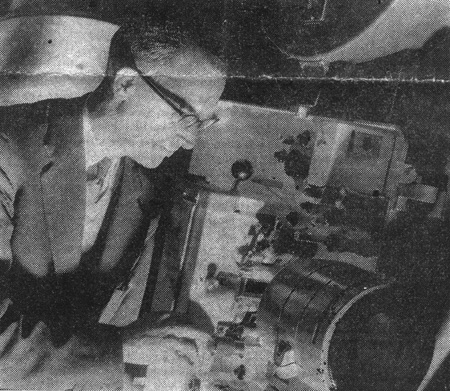 Jan
Jacob Kotte next to his DP70 prototype Jan
Jacob Kotte next to his DP70 prototype
Give
a twelve year old boy a vacuum cleaner and he will build his first
projector. That’s the way it’s all started. His mother couldn´t
find her vacuum cleaner, but she forgot to look in Jan’s bedroom. She
found the vacuum cleaner when the carpet in the living room caught on
fire. Jan’s first projector was, unfortunately, not so successful.
After
his education as an engineer he started to work for the Philips Cinema
company in Eindhoven September 1, 1929 as service engineer. At that time
Philips already was experimenting with equipment from companies like
Western Electric, Loetafoon, Nitsche, Fox Movietone and James Miller.
This equipment was used by Philips to help refine their own ideas in
development. At the same time my father gained a lot of experience by
travelling all over Europe and in installing Philips equipment in many
cinemas.
It
was the start of a great career in technical development of Philips
motion picture projectors which lasted more than sixty years. In 1938
the Philips company designed a modern series of film projectors, the so
called Family Program, of which Kotte designed the entire series. It was
a period of technically outstanding cinema products, many of which would
find their way into cinemas around the world. It was also the start of a
success story for the Philips Cinema Department culminating with the
projector-masterpiece of 1955, the OSCAR winning (1962) DP70 Todd-AO
70mm projector.
|
|
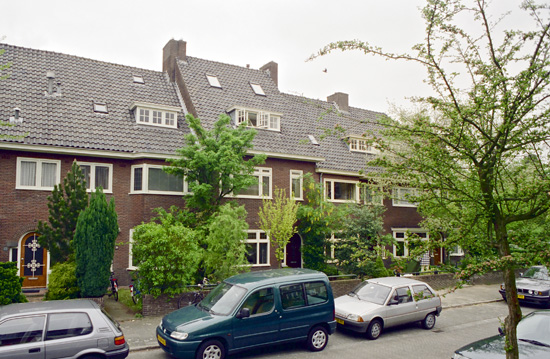 The
Todd-AO projector was developed in this house on Jacques Perkstraat in
surburbian Eindhoven. Picture by the Editor. The
Todd-AO projector was developed in this house on Jacques Perkstraat in
surburbian Eindhoven. Picture by the Editor.
From
about 1936 onwards he applied himself to designing and engineering
motion picture projectors. All basic design considerations and ideas for
the 16, 35 and 70mm Philips projectors came from my father and all
projectors had one main characteristic: picture steadiness. Many parts
of the projectors were made from cast iron. That’s one of the reasons
you will find Philips projectors still running all over the world. He
was always very proud when people said to him: “Jan, your projectors
run like a Rolls-Royce”. Continuing the development of progressive
technical equipment in sound and projection, many leading film companies
visited the Philips ELA Department in Eindhoven like American Optical
(Todd-AO) and 20th Century Fox (Cinemascope and 3-D).
|
|
Cinema
Team
|
|
|
 L-R:
Mr. A. G. Overmars, Mr. Jan J. Kotte, Mr. F J Rijke and Mr. W van Riet
posing with DP70 just after winning the OSCAR in 1963. L-R:
Mr. A. G. Overmars, Mr. Jan J. Kotte, Mr. F J Rijke and Mr. W van Riet
posing with DP70 just after winning the OSCAR in 1963.
After
the presentation of the DP70 70mm projector in 1955, demands for other
new innovations soon appeared. First of all, there was the question of
the light source. My father was a fan of the electric carbon arc lamp.
In his opinion this light source produced the proper red colour balance.
And that warmish colour on the screen identified for him the source of
light. But new light sources came into existence, for instance the
Mercury lamp and Osram´s Xenon bulb.
At
the same time the Cinema team was working on a entirely new concept, a
projector based on a main frame with possibilities for simpler
replacement and extension. The cast iron was replaced by sheet steel.
Another modification was the source of light. The new FP-projectors, the
20-series were supplied with the Mercury lamp. And finally the
non-rewind table "platter" was introduced in the early 1960s.
All
these developments were necessary in order to make the projectors
suitable for the newer cinemas. However, the non-rewind table was a
thorn in my father’s side. In my father´s opinion it was absolutely
necessary to transport the film from spool box to spool box in order to
avoid any dust and damage to the film. He did not want to have anything
to do with it.
|
|
The
Todd-AO Projector
|
|
|
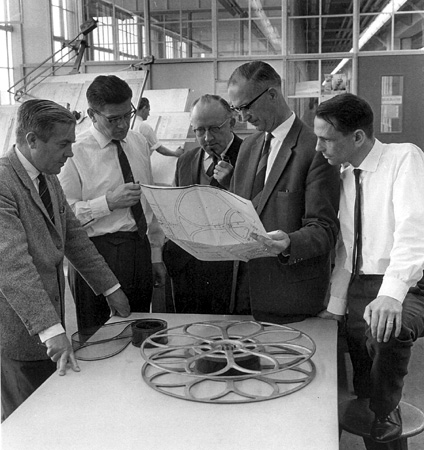 Philips factory 1963. L-R: J. Hallmann, P.
Fila, W. van Riet, Jan J Kotte, H. Goumans. In the background is Mr. B.
Kuppens. Philips factory 1963. L-R: J. Hallmann, P.
Fila, W. van Riet, Jan J Kotte, H. Goumans. In the background is Mr. B.
Kuppens.
In
August/September 1954, through American Optical Company in Southbridge,
Mass., in USA, showman
Michael Todd and Professor Brian O’Brien commissioned Philips Cinema
to develop a projector that could strengthen the impression of
“realness” through the use of a 70mm wide film projected on a wide
screen in stereophonic sound. Additionally, with a few changes the same
projector should be able to project 35mm film. Hence the name; DP70. Jan
Kotte travelled frequently and knew both Todd and O´Brien. (Note #1) .
American
Optical Company needed the projector in a hurry. Realizing this fact,
Philips moved my father's drawing board to the attic room in our house
in Eindhoven and in less than one year, he succeeded in developing a
prototype Todd-AO projector. Working at home in 1954/55, in an attic
room with only an old-fashioned oil-stove was considered very unusual in
those days. The DP70 took form in our house. (Note #2)
The
abbreviation DP stands for double projector (70mm/35mm), but my father
always spoke about his Dollar Princess because he knew that from a
commercial point of view, the projector would be very successful.
|
|
 Sitting L-R: Jan J Kotte, Brian O'Brien, Henry
S Woodbridge, Unidentified. Sitting L-R: Jan J Kotte, Brian O'Brien, Henry
S Woodbridge, Unidentified.
His
efforts culminated when the Todd-AO system was presented to the public
on October 13, 1955 with the film “Oklahoma!”, shown in the
Rivoli Theatre on Broadway in New York.
The
most remarkable moment came at the end of a working day in 1963. My
father entered our living room, wearing a hat and coat, which was very
unusual for him, and told to us: “We won an OSCAR"! The whole
family was very surprised, looked at each other and said : “What is he
talking about?”. Of course the OSCAR award is considered to be a
technical apex in his career. In his view, winning the OSCAR was a team
effort, and his Cinema team at ELA lived up to that statement. Every
time he had a big smile on his face, the Cinema team said to him: “Jan
J. Kotte, for perfection in sound and projection”. He never used this
statement himself.
|
|
His
Retirement
|
|
|
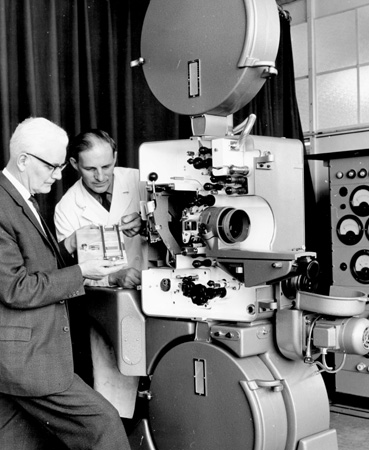 Mr.
A. G. Overmaars and Mr. Postema Mr.
A. G. Overmaars and Mr. Postema
At
the end of 1970 Philips Cinema sold the cinema activities to one of its
agencies: Kinoton in Munich, Germany. Kinoton took over the research,
marketing and sale of Philips projectors. The Philips Cinema department
was closed.
My
father had retired in 1969, after 40 years with Philips Cinema. After
his retirement he continued to work for Kinoton. Until three months
before he died he spent almost 70% of his time on cinema projects. There
were always improvements to aim for. Conversations with projectionists
gave my father many ideas for adjustment to modern conditions. Whenever
my father entered a cinema there always was a reception committee, the
manager and the projectionists. They treated him like a special guest,
because they knew he would solve their problems in a split second. The
sound of the projector mechanism running was enough to tell him almost
everything about conditions inside, like a doctor taking your pulse and
temperature.
|
|
The Oscar
|
|
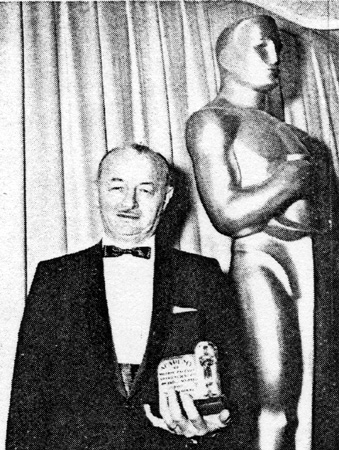 Mr. Fred J. Pfeiff, Technical Manager of
the Norelco Motion Picture Department, proudly holds Golden Oscar Plaque,
received at the 35th Annual Academy Awards presentation, April
8, 1963. (From The ELAgraph
Volume 9, Number 2, May 1963. Mr. Fred J. Pfeiff, Technical Manager of
the Norelco Motion Picture Department, proudly holds Golden Oscar Plaque,
received at the 35th Annual Academy Awards presentation, April
8, 1963. (From The ELAgraph
Volume 9, Number 2, May 1963.
"This
sturdy multi-purpose projector is capable of projecting 70mm and 35mm film
with any combination of photographic or magnetic sound tracks. Its unique
design provides for rapid conversion to either 70mm or 35mm projection and
for operation with significantly reduced film wear and damage".
|
|
Editors
notes
|
|
|
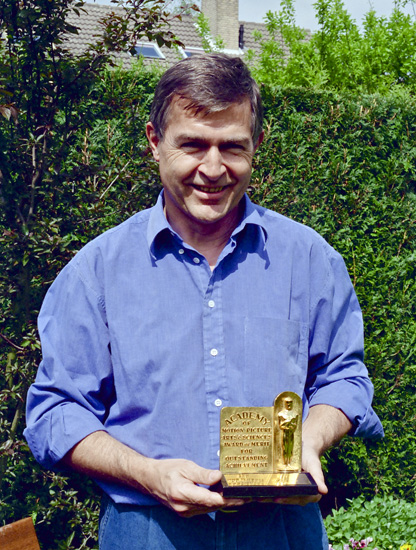 Mr.
Anton P Kotte in May 1998 with the DP70 Oscar. Picture by editor. Mr.
Anton P Kotte in May 1998 with the DP70 Oscar. Picture by editor.
Note
#1)
American Optical Company contracted with Philips (projector equipment),
AMPEX (sound system), Mitchell Camera Corporation (cameras) and Altec
(speakers) to make the Todd-AO system for MAGNA, who came up with the
money. AO and MAGNA formed The Todd-AO Corporation to market and
distribute the Todd-AO system. It was Brian O'Brien´s suggestion that
Philips should build the projector and to train AO crew to use the
projection equipment, as he knew Kotte.
Note
#2)
The basic design of the DP70 was worked out in close cooperation with Mr.
Bill Peck (General Manager of Motion Picture Division of American Optical
Company´s Instrument Division in Buffalo, N.Y., USA) and Kotte´s
co-engineers at Philips Cinema in Eindhoven: Mr. A.G.Overmars, Mr.
F.J.Rijke, Mr. W. van Riet and Mr. J. Sliepenbeek.
|
|
|
|
Go: back
- top - back issues
Updated
22-01-25 |
|
|
 The
Todd-AO projector was developed in this house on Jacques Perkstraat in
surburbian Eindhoven. Picture by the Editor.
The
Todd-AO projector was developed in this house on Jacques Perkstraat in
surburbian Eindhoven. Picture by the Editor. Sitting L-R: Jan J Kotte, Brian O'Brien, Henry
S Woodbridge, Unidentified.
Sitting L-R: Jan J Kotte, Brian O'Brien, Henry
S Woodbridge, Unidentified. Mr. Fred J. Pfeiff, Technical Manager of
the Norelco Motion Picture Department, proudly holds Golden Oscar Plaque,
received at the 35th Annual Academy Awards presentation, April
8, 1963. (From The ELAgraph
Volume 9, Number 2, May 1963.
Mr. Fred J. Pfeiff, Technical Manager of
the Norelco Motion Picture Department, proudly holds Golden Oscar Plaque,
received at the 35th Annual Academy Awards presentation, April
8, 1963. (From The ELAgraph
Volume 9, Number 2, May 1963.




 Mr.
A. G. Overmaars and Mr. Postema
Mr.
A. G. Overmaars and Mr. Postema